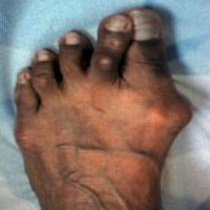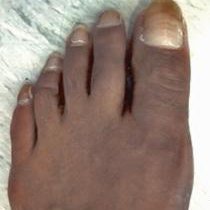Bunions / arthritis
A bunion is a deformity of the great toe joint where the 1st toe drifts towards the lesser toes. Usually, a prominent "bump" forms on the inside of the foot as a consequence of the joint becoming more prominent. Often, the smaller neighbouring toes drift out of position and this is one indication for surgery so as to to avoid the development of a more extensive forefoot deformity.
When the bunion presses on shoes, then the only solution is wider shoes or surgical correction. When pain arises within the great toe joint, then specialised insoles, various types of injection and shoe modification can be undertaken.
There over a 100 different types of bunion operation although a handful of operations are mainly used within the UK. At our Centre minimally invasive surgery is sometimes undertaken but only if the bunion is suitable as large bunions requiring a layered more complex correction that can best undertaken by means of an open approach, so that the surgery can correct all aspects of the deformity. Operations at our Centre are performed under local anaesthetic on a day care basis and patients usually go home within a few hours. No cast is generally required and post operative pain is well controlled thanks to the use of long acting anaesthetics.
HALLUX RIGIDUS / GREAT TOE ARTHRITIS
Sometimes the great toe joint becomes arthritic and stiff without significant deviation. This condition is often referred to as hallux rigidus. When the toe is limited in movement (but not completely stiff) is sometimes referred to as hallux limitus.
There are a number of Conservative techniques to treat the condition and certain types of footwear and specialist orthotic can be helpful. Injections also play a role including the use of hyaluronic acid.
When conservative care fails then surgery will depend on the amount of damage to the joint. In mild to moderate cases the arthritic bone can simply be cut and shaved away leaving the majority of the joint intact. This procedure is often referred to as a cheilectomy. When possible, this is the preferred approach. However in some cases the arthritis is to extensive and in such circumstances three main surgical options exist. These consist of a joint fusion, the use of artificial joint or an interposition of arthroplasty.
Fusions should be avoided if possible (although sometimes there are no other reasonable options) because of their adverse biomechanical effect on walking. Patients with fused joints are, in the Centres experience more likely to experience knee pain and other symptoms because of an alteration in gait. Artificial joints can be successful, but some patients develop resistance, whilst in others the joints fail and the toe remains very stiff. At the London podiatry Centre, when possible we prefer to use a modified into positional arthroplasty technique. This has been developed and pioneered within the centre to include a number of refined additional steps. The operation results in the patient’s own tissue being used to create a spacer after the removal of some bone from the great toe joint. Recovery is fairly rapid and the procedure is generally undertaken under local anaesthetic. Most patients can return to work within 2 to 3 weeks and the toe remains mobile so facilitating a more normal gait.
CASE STUDY
This patient had identical toe deformities on each foot and opted to have the left, more painful foot operated on first. The left foot has been surgically corrected at the Centre.
The patient was able to walk immediately after her operation and no cast was required.


Bunions / arthritis FAQ
what is a bunion?
A bunion occurs when the great toe joint become enlarged. There is usually associated drift of the great toe towards the second toe.
How do I get bunions on my feet?
Many studies have been done to try and determine what causes a bunion, but the cause is multifactorial. For example, some patients have a broad foot type, and by wearing tight, narrow footwear, the toe has been pushed over. In some cases, the first metatarsal develops in a more inwardly pointed position, and this can also cause a bunion to form. Sometimes, it is a genetic cause, and hypermobility (joint laxity) has been associated with bunion formation.
Do bunions go away?
Generally, not. If the bunion is established, it is very hard to reverse. Some studies in children have shown a splint can be helpful in the short term, but it does not cure it.
Can you get rid of a bunion on your own?
There are literally hundreds of devices on the market for bunions. Unfortunately, there is no evidence that any of them work. However, in the initial stages of the development of a bunion, home treatments such as wide footwear and bunion splints can minimize the symptoms. In addition, there is evidence that an orthotic can help with bunion pain and some anecdotal experiences which would suggest that the bunion can appear slightly improved with an orthotic when used for long-term, although the scientific research is not there yet.
How can I shrink my bunions naturally?
This is very difficult if the bunion is due to a bony deformity. However, some bunions are caused by fluid build-up called a bursa. Using anti-inflammatories can reduce inflammation, which can be effective and improve comfort. However, the underlying cause, which is a misalignment of the foot bones, cannot be treated without surgery.
Do bunions go away?
Generally speaking, it is very hard to get rid of bunions once they are established, except for the soft tissue swelling, which can improve with anti-inflammatory measures.
How do I get rid of bunions on my feet?
If you have an established bunion deformity where the bones have moved, then surgery is the only way to remove them.
What’s the best treatment for bunions?
In many cases, a bunion can be managed conservatively by wearing wide shoes and orthotics, but if the bunion is too established and causes problems because of footwear pressure, it may be necessary to consider surgery.
How painful is bunion surgery?
Bunion surgery is generally tolerated very well by patients. Here, at The London Podiatry Centre, the procedure takes less than an hour and is performed under local anaesthetic. A patient is provided with painkillers and long-lasting anaesthetic afterwards, which keeps any discomfort very manageable. Typically, you might experience pain levels of 4 to 5/10 when the anaesthetic wears off, but this does not last more than a day or two.
Is bunion surgery worth having?
This depends on your individual circumstances. For some people, surgery is the only answer because they want to get rid of the deformity and associated pain. In other cases, the problem can be managed with wide footwear, orthotics and other conservative treatments.
How bad does a bunion have to be to have surgery?
Relatively mild bunions can cause significant pain and, in this instance, surgery might be necessary. In other cases, a severe bunion in terms of the level of deformity may not cause too many problems because the patient wears wide shoes. Therefore, it is not necessarily the extent of the deformity that determines the surgery. However, one factor that can be very helpful in determining whether to have bunion surgery is whether the first toe is beginning to deform the rest of the foot. In many ways, it would be better to have surgery before this occurs as otherwise, surgery to correct the bunion might also involve a further procedure to correct the lesser toes that have become affected by the bunion deformity.
How long does it take to recover from bunion surgery?
Typically, it is 6-8 weeks before you can be active to within reasonably normal levels. You will be provided with a protective shoe or boot to use during this time. Stitches are generally removed at week 2. However, it will be several months before you begin to function normally, and improvements can be expected for up to a year.
What is the newest bunion surgery?
There are about 100 different bunion operations, with some being far more popular than others. Minimally invasive (keyhole) surgery has become more popular, but patients have to be selected carefully as in some cases, it is simply not worth having minimally invasive surgery because of the reduced risk of an optimal outcome. Ron McCulloch at The London Podiatry Centre has performed minimally invasive surgery and will consider it. Still, in most instances, open surgery can be a better option for patients. This is because minimally invasive surgery limits what the surgeon can see when performing the operation, which means that not as many steps can be undertaken to fully correct the deformity.
What is the best bunion procedure?
This depends entirely on the type of bunion that you have. However, one of the most common procedures in the UK is a Scarf osteotomy. This involves cutting a ‘Z’ in the bone, realigning it, and then fixing it with wires or screws. This is one of the preferred procedures at the London Podiatry Centre.
What are the different types of bunion surgeries?
There are up to a hundred different types of operations but the most popular includes the scarf osteotomy, which involves cutting a long ‘Z’ in the bone, A Chevron osteotomy which involves cutting a ‘V’ in the bone, and a Lapidus procedure which involves fusing the joint in the middle of your foot.
What are the benefits of bunion surgery?
Most people who have bunion surgery experience significant pain relief when they recover. The surgery can improve your big toe alignment which can help you walk more easily. Footwear choice can also be an advantage.
How much is bunion surgery?
The cost of bunion surgery depends on what type of operation you have. The London Podiatry Centre offers different types of surgery and costs will vary. Please call the Centre for more information.
When can I wear normal shoes after bunion surgery?
Usually about 3-4 weeks but shoes need to be wide and soft, and trainers are ideal.
Are bunions related to back pain?
Back pain is often the result of bad posture, and bunions are one complaint that can contribute to poor posture. Bunions spread the feet and arch out, which can eventually lead to back pain.
Will bunion surgery prevent recurrence?
Recurrence is a risk but is generally uncommon because of the way that the position of the bones are corrected.

